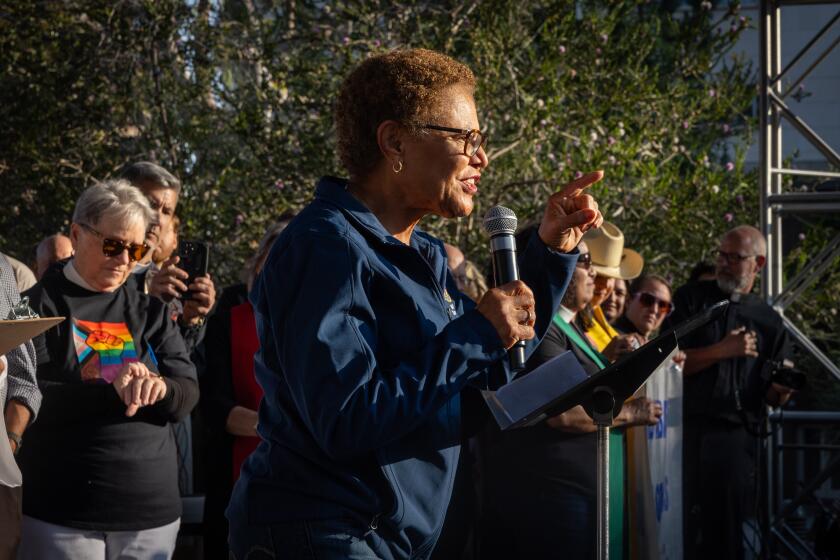UC seeks $500 million in administrative, purchasing and energy savings
- Share via
Reporting from San Francisco — The University of California plans to reduce its administrative, purchasing and energy costs about $500 million a year by 2015 in an attempt to shield its teaching and research missions from further cuts in state funding, officials said Wednesday.
The push for efficiencies could shift UC’s institutional culture somewhat, from a relatively loose system of 10 campuses to a more centralized university, UC leaders said. But they emphasized that campuses and academic departments will maintain independence in the classrooms and labs.
“It will involve some inconvenience for people,” UC President Mark G. Yudof said Wednesday as he addressed the Board of Regents in San Francisco. “But for some slight inconvenience, we can save a lot of money and be in the position to put it back in students, faculty and staff, where it belongs in the first place.”
The announcement comes at a politically sensitive time as the public university system and other state entities are under pressure to be more efficient and frugal. Last week, Gov. Arnold Schwarzenegger proposed severe cutbacks in social services and healthcare for the poor while restoring $305 million of the funds chopped from UC last year. Angry about recent large fee increases and staff furloughs, student activists and labor unions say the system remains top-heavy with highly paid administrators.
Peter J. Taylor, UC’s executive vice president and chief financial officer, said the university had launched as many as nine smaller-scale efficiency efforts in the past but none had been fully implemented because the urgency evaporated when the state economy improved. Now, the state’s deficit problems are here for the long haul and UC must be dramatically streamlined, he said.
“Our money comes from taxpayers and students. This is an attempt to firmly represent to them that we are good stewards of their money,” Taylor said in an interview.
For example, he said, more unified purchasing for supplies, from copy paper to medical equipment, could save $100 million a year. Other areas to be explored include shared data centers, common payroll systems and centralized human resources departments.
Bob Samuels, a UCLA lecturer who is president of UC- American Federation of Teachers, which represents more than 4,000 lecturers and librarians, said he welcomed the plan, though much of it should have been done years ago.
“I think there is a lot of excess and waste they can probably cut,” he said, adding that employees will be watching closely “to see whether the administrators are willing to cut themselves rather than the people who work for them.”
Taylor said one goal of the “Working Smarter” plan is to reduce administrative jobs by an unspecified amount through attrition, not layoffs, and then use the savings for teaching and research. UC has about 118,000 full-time employees, and about 10,000 retire or leave every year, he said.
Savings of $500 million would represent 2.5% of UC’s annual operating budget, but officials contend it is more appropriate to describe the potential savings as being more than 9% of the university’s core $5.3-billion budget, which does not include most of the revenues from hospitals and federally funded research.
Even if the governor’s budget plan survives upcoming legislative debate, UC says it would remain $237 million below its state funding of two years ago.
Regents, who were not required to take a formal vote on the plan, expressed strong support. At least one, Leslie Tang Schilling, said she was frustrated that UC officials had talked about efficiency for so long “without a lot of action.”
In another move, UC will soon require more controls and public disclosure in how schools spend the $900 registration fee that all students pay annually to support student services such as counseling, recreation and cultural events. Student leaders have suspected that some of the funds have been used for other purposes over the years as campuses tried to plug budget holes, although a recent report found no violations, Student Regent Jesse Bernal said.
Under a plan given preliminary approval Wednesday and set to be voted on by the full board Thursday, the charge will be called a “student services” rather than “registration” fee. And to avoid possible misuse of the $165 million a year it generates, the new policy requires that the money be spent only on services and programs “that directly benefit students.” In addition, it urges campus chancellors, “as much as possible,” to follow the spending recommendations of student advisory groups.
Victor Sanchez of the UC Student Assn. welcomed the change, saying “it not only ushers in a greater sense of accountability but also new shared governance between students and administrators.”
More to Read
Sign up for Essential California
The most important California stories and recommendations in your inbox every morning.
You may occasionally receive promotional content from the Los Angeles Times.














